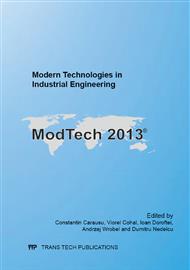p.483
p.489
p.495
p.500
p.506
p.511
p.517
p.525
p.531
Drying Simulation of Shrinkable Clay Tiles Using Variable Diffusivity Model
Abstract:
This paper represents the upgrade of our previous study in which we have presented a model for simulation of the drying kinetic and estimation of the effective moisture diffusivity of clay tiles using a constant diffusivity model. The main objective of this study is to determine the time - dependent effective moisture diffusivity of shrinkable clay tiles. Experimental investigations were carried out, on clay tiles, in a laboratory recirculation dryer in which drying parameters (humidity, temperature, and velocity) could be programmed, controlled and monitored during drying. Results presented in this study have shown that the proposed drying model describes and correlates accurately drying kinetics and gives a reliably estimation of the time - dependent effective moisture diffusivity.
Info:
Periodical:
Pages:
506-510
Citation:
Online since:
November 2013
Authors:
Keywords:
Price:
Сopyright:
© 2014 Trans Tech Publications Ltd. All Rights Reserved
Share:
Citation:


